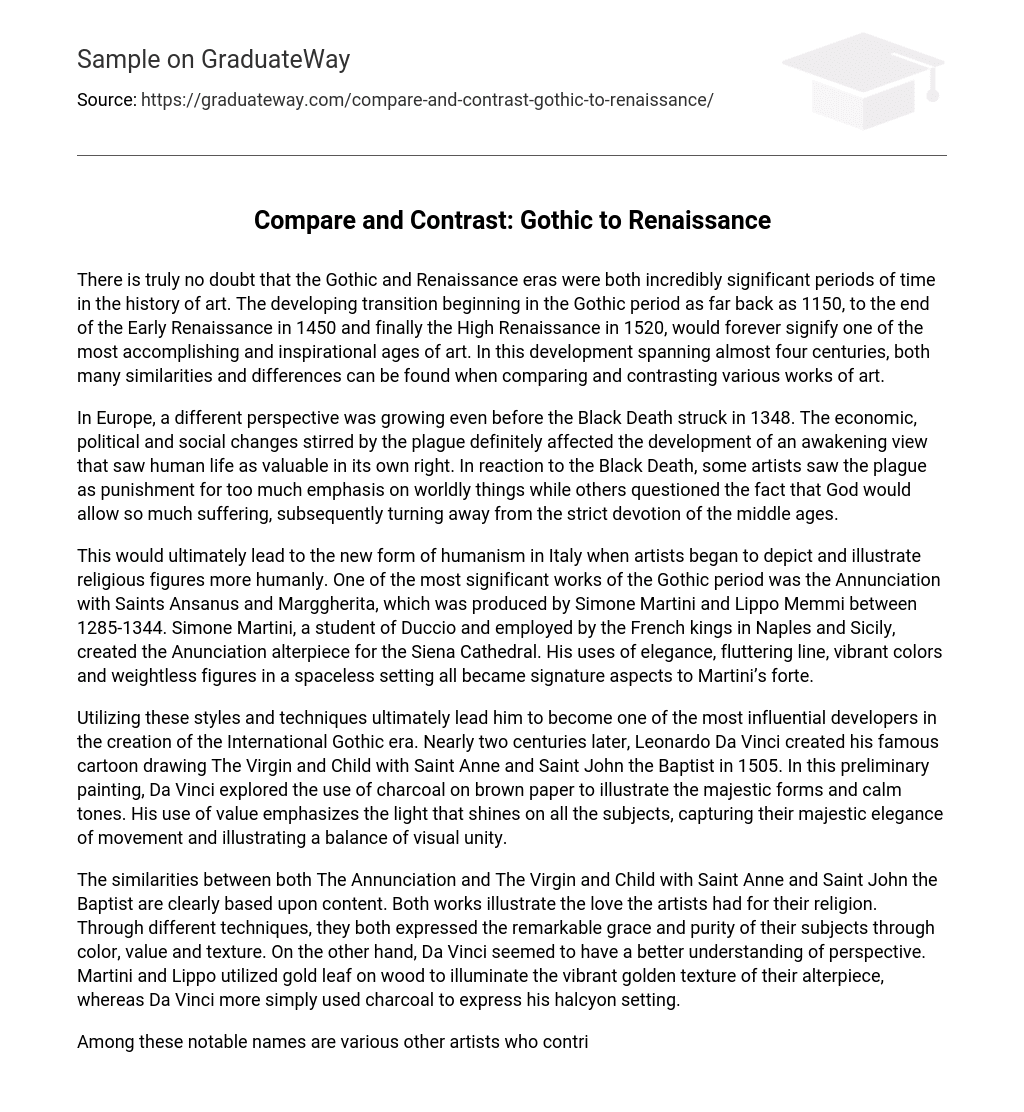There is truly no doubt that the Gothic and Renaissance eras were both incredibly significant periods of time in the history of art. The developing transition beginning in the Gothic period as far back as 1150, to the end of the Early Renaissance in 1450 and finally the High Renaissance in 1520, would forever signify one of the most accomplishing and inspirational ages of art. In this development spanning almost four centuries, both many similarities and differences can be found when comparing and contrasting various works of art.
In Europe, a different perspective was growing even before the Black Death struck in 1348. The economic, political and social changes stirred by the plague definitely affected the development of an awakening view that saw human life as valuable in its own right. In reaction to the Black Death, some artists saw the plague as punishment for too much emphasis on worldly things while others questioned the fact that God would allow so much suffering, subsequently turning away from the strict devotion of the middle ages.
This would ultimately lead to the new form of humanism in Italy when artists began to depict and illustrate religious figures more humanly. One of the most significant works of the Gothic period was the Annunciation with Saints Ansanus and Marggherita, which was produced by Simone Martini and Lippo Memmi between 1285-1344. Simone Martini, a student of Duccio and employed by the French kings in Naples and Sicily, created the Anunciation alterpiece for the Siena Cathedral. His uses of elegance, fluttering line, vibrant colors and weightless figures in a spaceless setting all became signature aspects to Martini’s forte.
Utilizing these styles and techniques ultimately lead him to become one of the most influential developers in the creation of the International Gothic era. Nearly two centuries later, Leonardo Da Vinci created his famous cartoon drawing The Virgin and Child with Saint Anne and Saint John the Baptist in 1505. In this preliminary painting, Da Vinci explored the use of charcoal on brown paper to illustrate the majestic forms and calm tones. His use of value emphasizes the light that shines on all the subjects, capturing their majestic elegance of movement and illustrating a balance of visual unity.
The similarities between both The Annunciation and The Virgin and Child with Saint Anne and Saint John the Baptist are clearly based upon content. Both works illustrate the love the artists had for their religion. Through different techniques, they both expressed the remarkable grace and purity of their subjects through color, value and texture. On the other hand, Da Vinci seemed to have a better understanding of perspective. Martini and Lippo utilized gold leaf on wood to illuminate the vibrant golden texture of their alterpiece, whereas Da Vinci more simply used charcoal to express his halcyon setting.
Among these notable names are various other artists who contributed to the Gothic and Renaissance periods. Their development of style and technique continued for centuries to come.
Bibliography
Kleiner Fred. (2012) Gardner’s Art Through the Ages. 14th Edition. N. p. Wadsworth Publishing. Print. “Leonardo Da Vinci’s Life. ” Leonardo Da Vinci’s Life. N. p. , n. d. Web. 25 Oct. 2012. <http://www. davincilife. com/>. “Martini, Simone. ” WebMuseum:. N. p. , n. d. Web. 25 Oct. 2012. <http://www. ibiblio. org/wm/paint/auth/martini/>.





